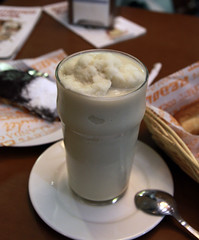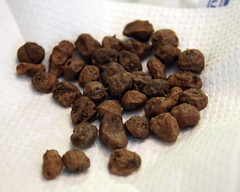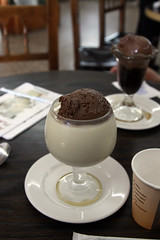Right after getting into Valencia, we had to go strait to our hotel in the outskirts of Valencia in a quiet little suburb known as Alboraya.
Alboraya’s claim to fame is being the birthplace to the Horchata (also spelled Orchata, or Orxata in Valencian), the drink common to several Hispanic nations. The proper Valencian version has exactly three ingredients, water, chufa (tigernuts), and sugar. (The related Mexican horchata is generally made from rice or almonds and is spiced).
One legend links the origins of the name to James I of Aragon, who after being given the drink for the first time by a local in Alboraya, was said to have exclaimed “Això és or, xata!” (“That’s gold, darling!”)
In any case, the town of Alboraya is almost a shrine to the Horchata. The main street is Avenida de Horchata, and there are about a dozen horchaterias nearby, with Horchata Daniel being one of the most revered. So we went there to recuperate from our flight (we went at 1:30 am, which isn’t “late” in Spain, this photo is from a later visit). Indeed, true to Spanish form, the place was quite happening, with most of the tables being filled with young couples or small groups going out to enjoy the Horchatas and many helados (ice creams) offered by Daniel.
Of course, I had to get the Horchata. Being offered it either as liquid (liquida) or frozen (granizado), I opted for the latter, since it was still rather warm out. The resulting drink, shown here, was rather pleasant. Tasting somewhat similar to almond milk or a milkshake, it’s a light, refreshing drink reminiscent of a nutty milkshake. A properly made Horchata de Chufa (I discovered during my visit that there is even a certifying authority for “authentico” horchata de chufas) has a nice robustness of flavor, which, quite frankly, I greatly prefer over the Latin American horchatas using almonds or rice (I can’t blame them, however, since you can’t make a horchata de chufa without chufa). We did discover sampling various other Horchatas around town that there is an art to making a proper one, since a few of the ones we sampled were gritty and/or chalky, but the ones from Horchata Daniel were silky smooth. As an added bonus, a proper Horchata is also dairy-free, so I didn’t always have to lug my pills around.
The waiter at Daniel was also nice enough to see that, as camera-toting tourists, we might need some explanation, so he came by and brought us a plate of chufas that we could sample, and explained what made the Valencian Horchata different from the Mexican ones I may have tried.
The next question, however, is how do you actually consume the horchata? There’s a classic methodology to this in Valencia, which is the following process: (1) Order an ice-cold horchata. (2) Order a plate of fartons. (3) Consume horchata and fartons, primarily by dipping the fartons in the horchata. (4) Repeat. The overall process is really similar to that of Cafe du Monde in New Orleans (where you do the same with iced coffee and beignets).
Of course, this begs the question, what the heck is a “farton”? The answer is simple, it’s a soft breadstick-like pastry, very slightly sweetened, designed to be dipped into your horchata, soaking up some of it, so that the breadiness of the farton is nicely complemented by the sweet, milky liquid. Actually, though, the fartons themselves aren’t that much by themselves, mostly tasting of bread. But this is by design, since there’s already a lot of sugar in the horchata. The combination, however, is splendid, and I hope I didn’t gain too much weight from the combination.
Over the trip, we also learned that horchata also makes a splendid base for several other desserts, such as what Horchata Daniel calls the “Flotaor”: a scoop of ice cream floated on frozen horchata, or the “Sospir”, a 50-50 blend of horchata and coffee granizado. Both were pleasant enough that we visited Horchata Daniel 6 times while we were in Alboraya, making us temporarily “regulars”. Doing my part to support the local chufa industry, I guess.
We didn’t limit ourselves to Horchata Daniel, either. Downtown Valencia also sports many Horchaterias, including Horchateria Santa Catalina and Horchateria El Siglo, both located a few meters off of Plaza de la Reina, and both having excellent Horchatas (the latter also having nice outside seating on the plaza, perfect for people-watching). Several of the mobile “Horxata” stands around the city (mostly by the tourist attractions) also serve up some nice horchatas,
So, if you ever find yourself even vaguely close to Valencia, I strongly suggest trying out the Horchata de Chufa. It’s cold, it’s refreshing, and it’s part of a tradition going back hundreds of years.
Horchata Daniel
Avenida de la Horchata, 41
46120
Alboraya, Spain
Horchateria Santa Catalina
Plaza Santa Catalina, 6
46001
Valencia, Spain
Horchateria El Siglo
Plaza Santa Catalina, 11
46001
Valencia, Spain







I love horchata and I really love Rumchata.